The UEFA Champions League got back underway on Tuesday night, with RB Leipzig ‘hosting’ Liverpool in Budapest. The match posed an interesting challenge for both teams, with Liverpool struggling in the Premier League to recapture their form of last season, while Leipzig were aiming to make a statement of intent in the tie. The matchup of managers was also an interesting one with a similar dynamic, with Julian Nagelsmann out to prove (if he still needs to) that he can battle it out and manage at the highest possible level. The match itself gave some answers to these questions, with the game a close-knit affair where both teams were probably happy with their overall performance, but Liverpool were obviously happier with the result.
Some pundits and fans seemed to criticise RB Leipzig following the game, suggesting that Liverpool had dominated the game and deserved to be clear winners, which is a statement I would disagree with. Leipzig showed their tactical nous and flexibility in the game and caused Liverpool problems at times, and their defensive structure made the game a very even one in my eyes, with Liverpool’s technical quality in the final third helping them to score their two away goals. Liverpool’s pressing also allowed them to control many moments of the game, and although they did not create many chances as such, they certainly forced the errors out of Leipzig. In this tactical analysis then, we will look at the pressing of Liverpool and how this allowed them to win the game, as well as looking at Leipzig’s own pressing and some concepts around their positional play tactics, which created some good opportunities for them.
Lineups
As predicted in my tactical preview for the game, Nagelsmann opted for a 3-1-4-2. Kevin Kampl acted as the six within this midfield, with Marcel Sabitzer and Amadou Haidara either side of him, while Leipzig also didn’t opt for a recognised striker, instead using Christopher Nkunku and Dani Olmo up front. Liverpool went with their usual 4-3-3, with the midfield of Gini Wijnaldum, Thiago, and Curtis Jones particularly impressive.
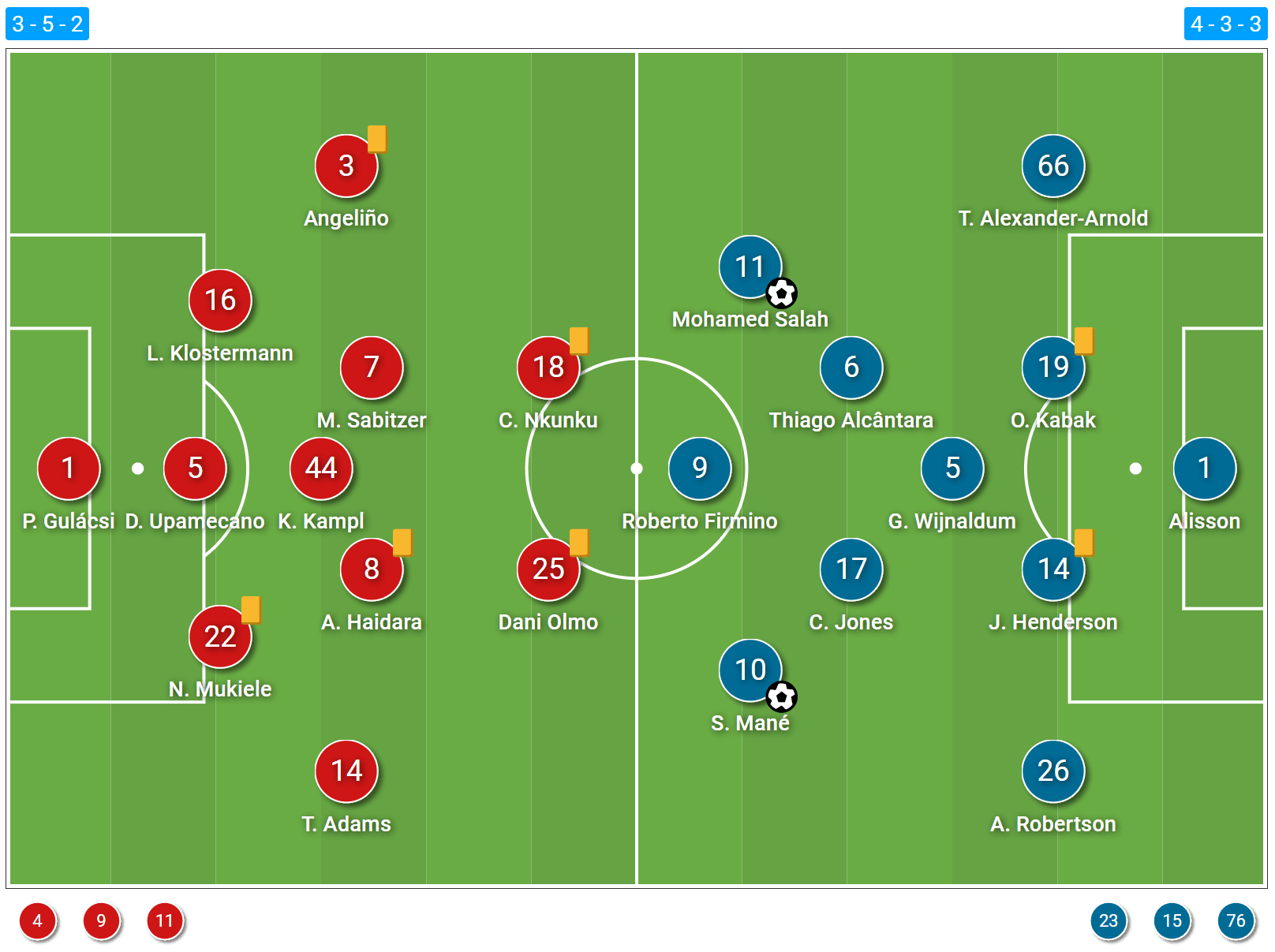
Leipzig pressing
Leipzig’s pressing shape was effective in the game and was very rarely broken by Liverpool, and much of this was down to their pressing in central areas. Leipzig pressed in a 3-1-4-2 formation with some slight flexibility in the midfield. This formation was chosen, as it aimed to maintain pressure on Liverpool’s full-backs at all times without sacrificing a central player either from defence or in midfield. The two strikers Olmo and Nkunku pressed the Liverpool centre backs, while the two higher Leipzig central midfielders (eights) would press any Liverpool midfielders in front.

The main reason for using this press I believe was to limit any central overload from Liverpool, as this image from my preview shows here. Liverpool used their common build up structure of a central midfielder dropping into the back line to form a back three, which allows a Liverpool full-back higher and helps to open the half-space and central areas. When they did drop a central midfielder deeper, naturally they now only had two central midfielders in advanced areas, and so Leipzig could actually create numerical superiority at times in this area.

This made even better when a striker would occasionally be able to cover a pivot or back press with them, as this added another body to midfield. Here we can see Olmo stays with Wijnaldum to prevent him from receiving, which allows Haidara and Sabitzer to cover two central midfielders, while Kampl could mainly focus on shielding the back four, with Nagelsmann not liking his back three to be exposed at all.

Kampl’s role also involved preventing Roberto Firmino’s dropping movements from creating overloads, as he could again shield the back four and react to Firmino making such movements at times. Crucially though, he wasn’t always able to do this due to Leipzig’s midfield staggering during pressing, which caused Upamecano and Leipzig some issues.

The main source of the problem for Leipzig was this midfield staggering with Kampl deeper, as at times you could end up with him just stood marking empty space while Liverpool created overloads deeper. Particularly in the first half, where Leipzig were more conservative, Liverpool could create a free player deeper, but often couldn’t actually access them due to other facets of Leipzig’s pressing.
We can see an example of Leipzig pressing early here, where Haidara moves higher to cover the pivot Wijnaldum. Sabizter stays with Thiago, but Kampl is off screen and stays screening the back three. Right wing-back Tyler Adams therefore keeps tabs on Curtis Jones. The pass into Jones isn’t accessible anyway due to Leipzig having continuous pressure against the back line, but Jones still needs to be covered effectively, so they adjust well.

We can see again here Jones drops wider and further from the ball, and so while Leipzig theoretically can maintain numerical equality in central midfield, they don’t necessarily have these players in the right places. Liverpool struggled to manipulate Leipzig in a way to access these kinds of passes, but it still impacted Leipzig’s pressing.

Here Leipzig striker Dani Olmo balances between a centre back and Jones, as Kampl or Sabitzer haven’t moved higher to occupy him, and Tyler Adams can’t be relied to tuck in every time as he needs to be close to Robertson to press.

We can see here from a goal kick, Curtis Jones takes up a good position high and wide close to Sabitzer. This attempts to pin him deeper in order to free one of the double pivots, with Haidara overloaded in this area Haidara presses the ball near pivot once the ball is played out, and is able to restrict him from receiving, and Leipzig’s pressure on the ball means a far side overload is difficult to access.

As a result then, when Liverpool could find better angles with which to manipulate Leipzig’s midfield pressing, Kampl would have to commit to prevent an overload. Here he does commit forward initially, before then back pedalling for fear of a long ball towards the back three. Liverpool work the ball wide and maintain the overload, before then switching play and putting Salah through on goal.

As the game went on then, Kampl became more man oriented in higher areas and was forced to press to nullify these overloads. We can see here at 1-0, Leipzig’s midfielders are matched up in a 3v3 and force Liverpool to play directly. However, the disadvantage to this was then that Kampl was no longer shielding that back line, and so it was a straight 3v3 when playing directly.

Liverpool’s second goal therefore came from this kind of situation, where middle centre back Dayot Upamecano was forced to track Firmino higher due to Kevin Kampl not shielding the back line and performing this role. This now leaves a 2v2 at the back, and a mistake by Mukiele leads to a goal for Liverpool. Kampl’s role started more zonally oriented in the opening parts of the game, but gradually became more man-oriented towards the nearest central midfielder as the game went on. Whether or not Upamecano actually needs to come for this ball here is a different question, but he certainly makes the decision based on the lack of cover from Kampl.

These kind of situations for Leipzig didn’t occur too often though and they rarely became disorganised in their pressing, with players swapping roles quickly and effectively when needed. In this example at 2-0 here, we still see the same organised pressing, with Leipzig adjusting to Liverpool moving a central midfielder wider. Nkunku drops to cover the wide lane, which naturally reduces cover of the pivot space, and so Yussuf Poulsen back presses to cover Wijnaldum to prevent an overload. You can see Nagelsmann instructing Nkunku on this image also.
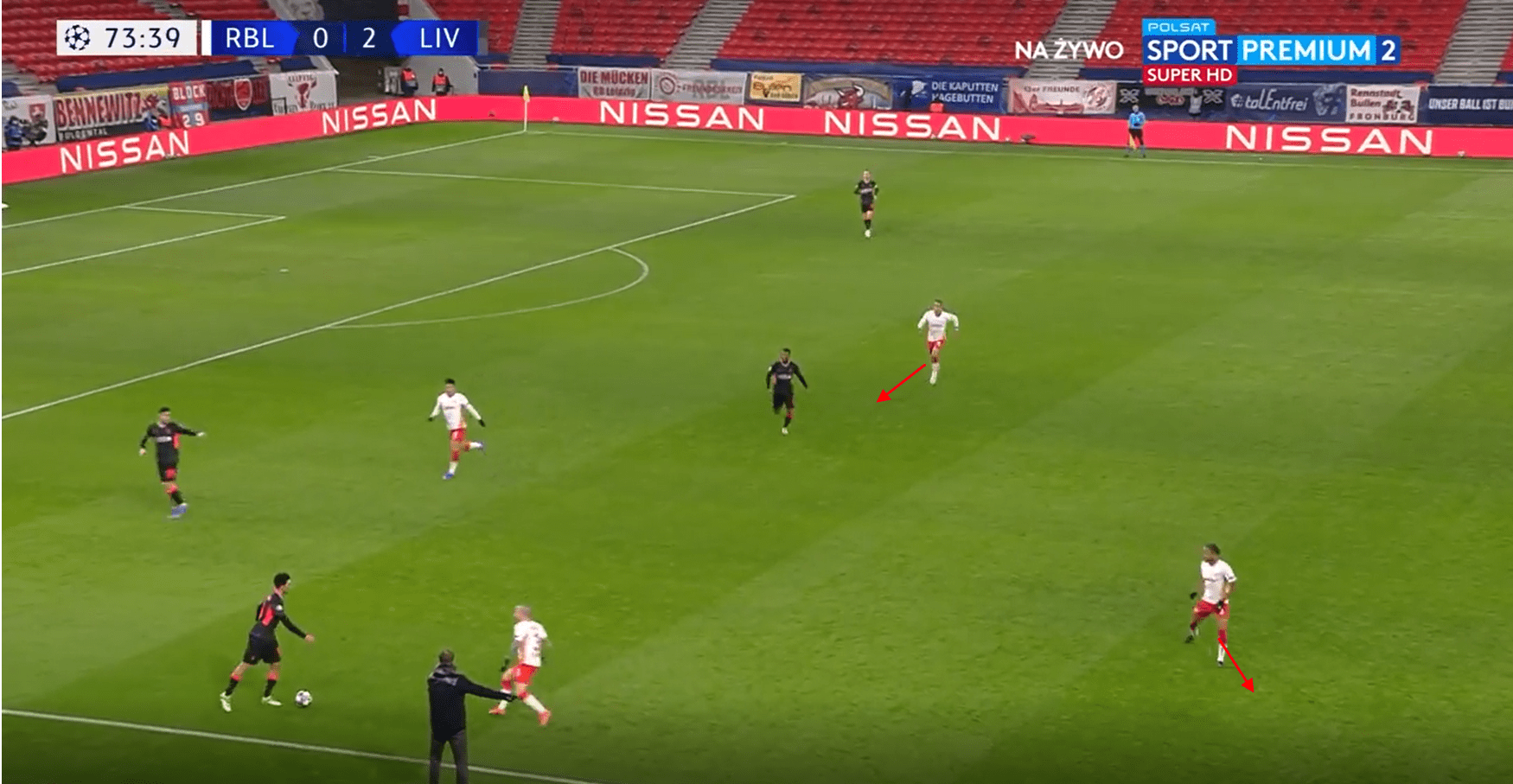
Curtis Jones, who for my money was Liverpool’s man of the match, was the biggest disrupter to Leipzig’s press, as he dropped from strange angles around Kampl and took up unorthodox positions as already shown just to confuse the press. We can see here he does a really good job of simply moving away from Kampl in the central area in order to receive, where he can then play forward due to the centre backs being pinned by the Liverpool forwards.
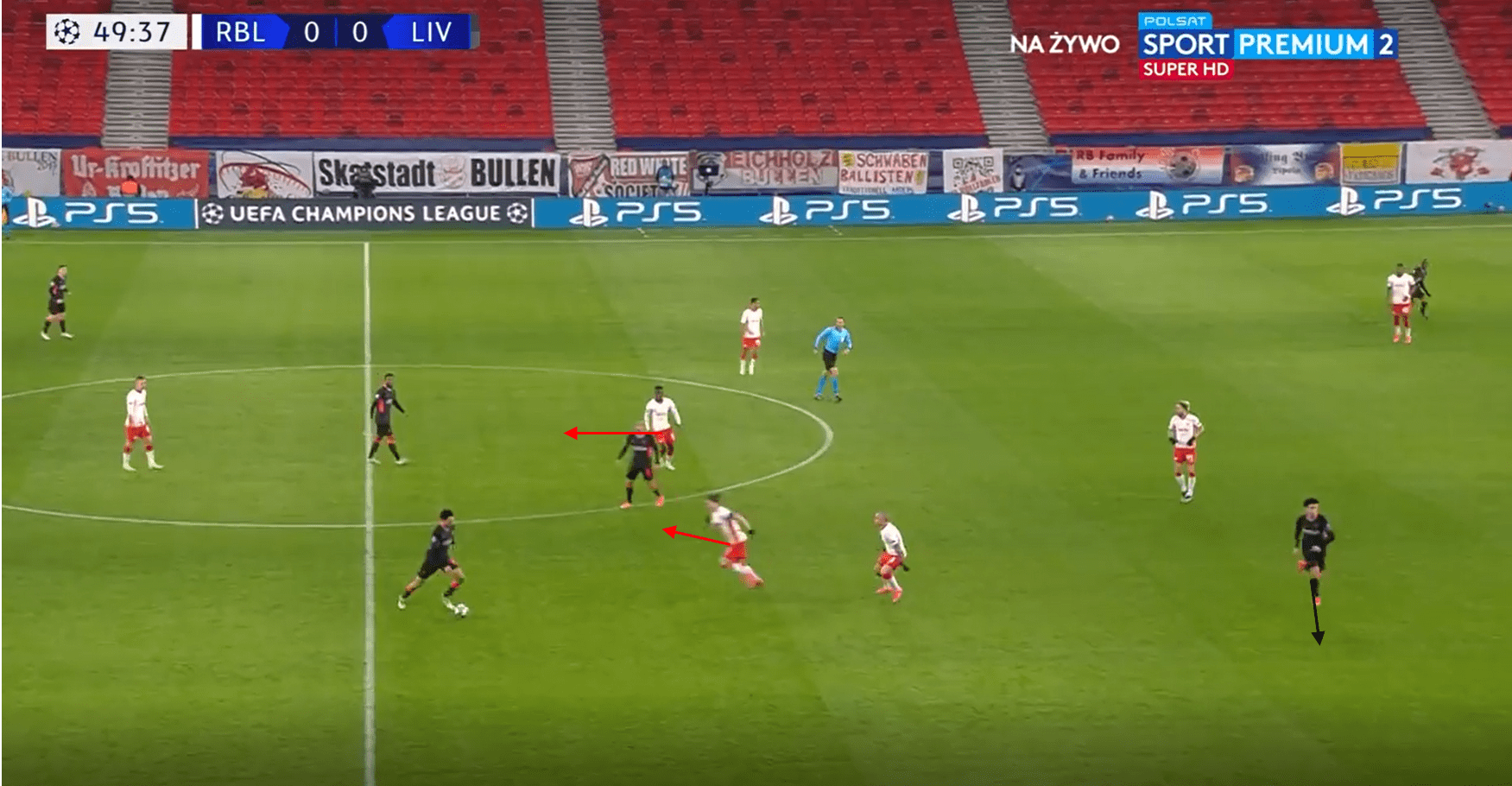
Liverpool’s pressing
Liverpool’s pressing was not anything particularly new, but they performed it very well thanks to their general spacing and shuffling across the pitch in the midfield. Liverpool seemed more ready to press wing-backs should they receive the ball, and were able to effectively commit a central midfielder slightly wider while pressing in order to prevent balls being played down the line or to apply pressure to the wing-backs.
Their structure kept the same approach, with the first line passing lane oriented and looking to force the ball into the centre, where Liverpool’s three central midfielders would look to pounce on any balls into this area.

Leipzig were forced into this area several times with differing effect, but they rarely ever broke the press completely. We can see an example here where Leipzig fall into the trap of playing into the centre but are able to still maintain possession. Salah’s pressing run leaves the inside passing lane open for Sabitzer to receive, where Liverpool are matched up 3v3 in the area. Jones gets tight to Sabitzer who is able to find Kampl, and Wijnaldum then jumps forward quickly to apply pressure to Kampl, who is able to retain possession well here. On other occasions Leipzig couldn’t do this, but this example shows some of the stability involved.

In this simple example here the central pass is left open again, with Olmo given enough time to receive before quickly being pressured. Olmo scans over his right shoulder first, and doesn’t see Wijnaldum, before then scanning on his left and seeing the pressing player. This pressure from behind puts Olmo under enough pressure to disrupt his pass and force the ball to go out of play for a Liverpool throw.

Here Upamecano receives the ball slightly higher as a six after rotating with Kampl, and again he is allowed to receive in the central lanes before then being pressed aggressively by a midfielder. Liverpool’s other two midfielders sit slightly deeper with the Leipzig players, and so when Upamecano’s pass is poor here due to the pressure on him, Liverpool can win the ball and counter. They go on to score with the goal later disallowed due to the ball maybe being out of play.

Liverpool’s pressing around Upamecano seemed particularly aggressive, although whether this was because of a weakness seen in him or rather just his position on the pitch is a question I can’t answer. On multiple occasions Salah would jump early and before Upamecano had controlled the ball in order to apply pressure, and at times he would be pressured by both inside forwards quickly, which of course funnels the ball directly into the centre where a player can be pressed from behind. We can see an example of this below.
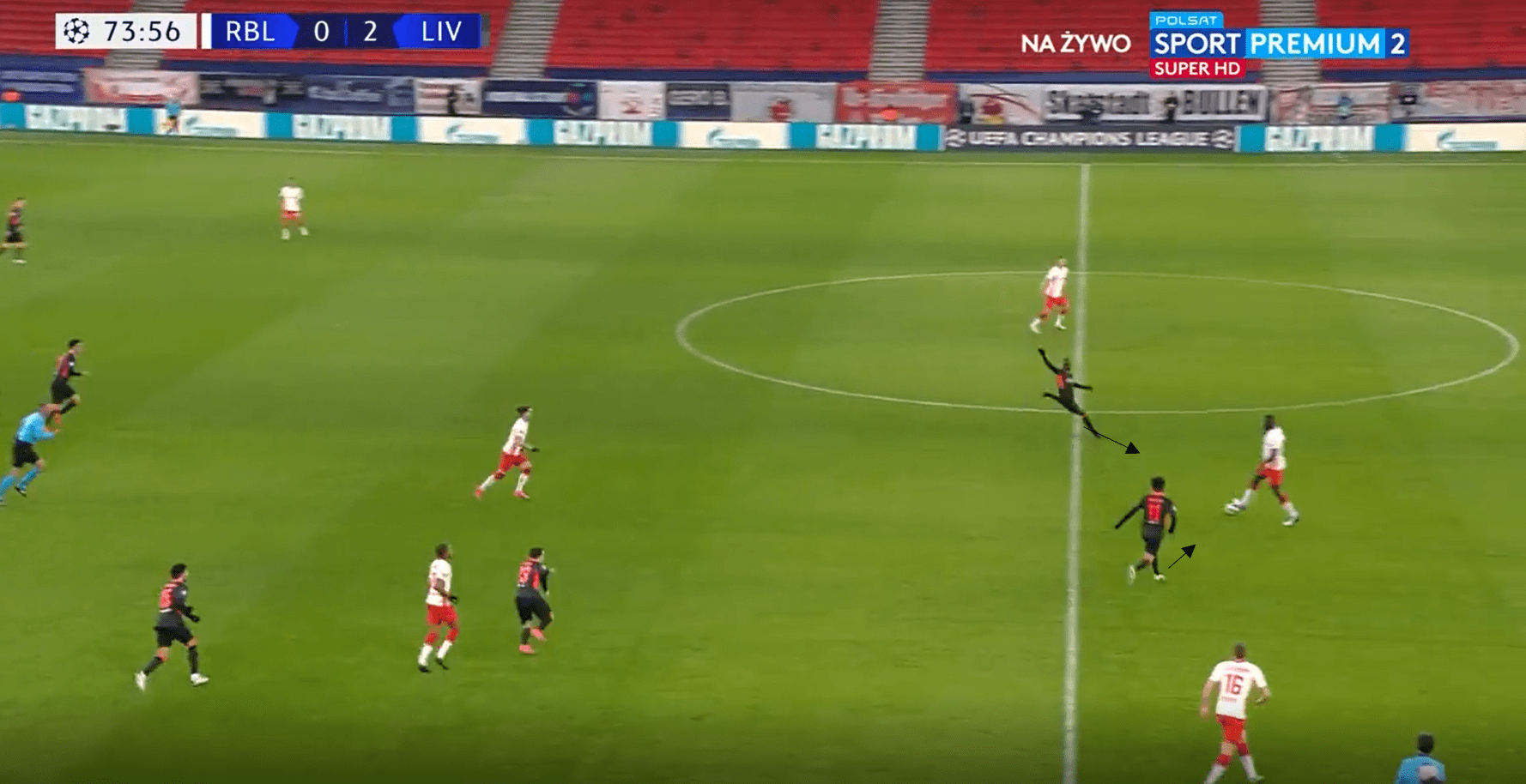
Here when Kampl hints at playing the ball back to Upamecano, Salah jumps higher in order to press aggressively, which compromises his pressing run slightly, although he is still able to prevent Kampl from escaping pressure.
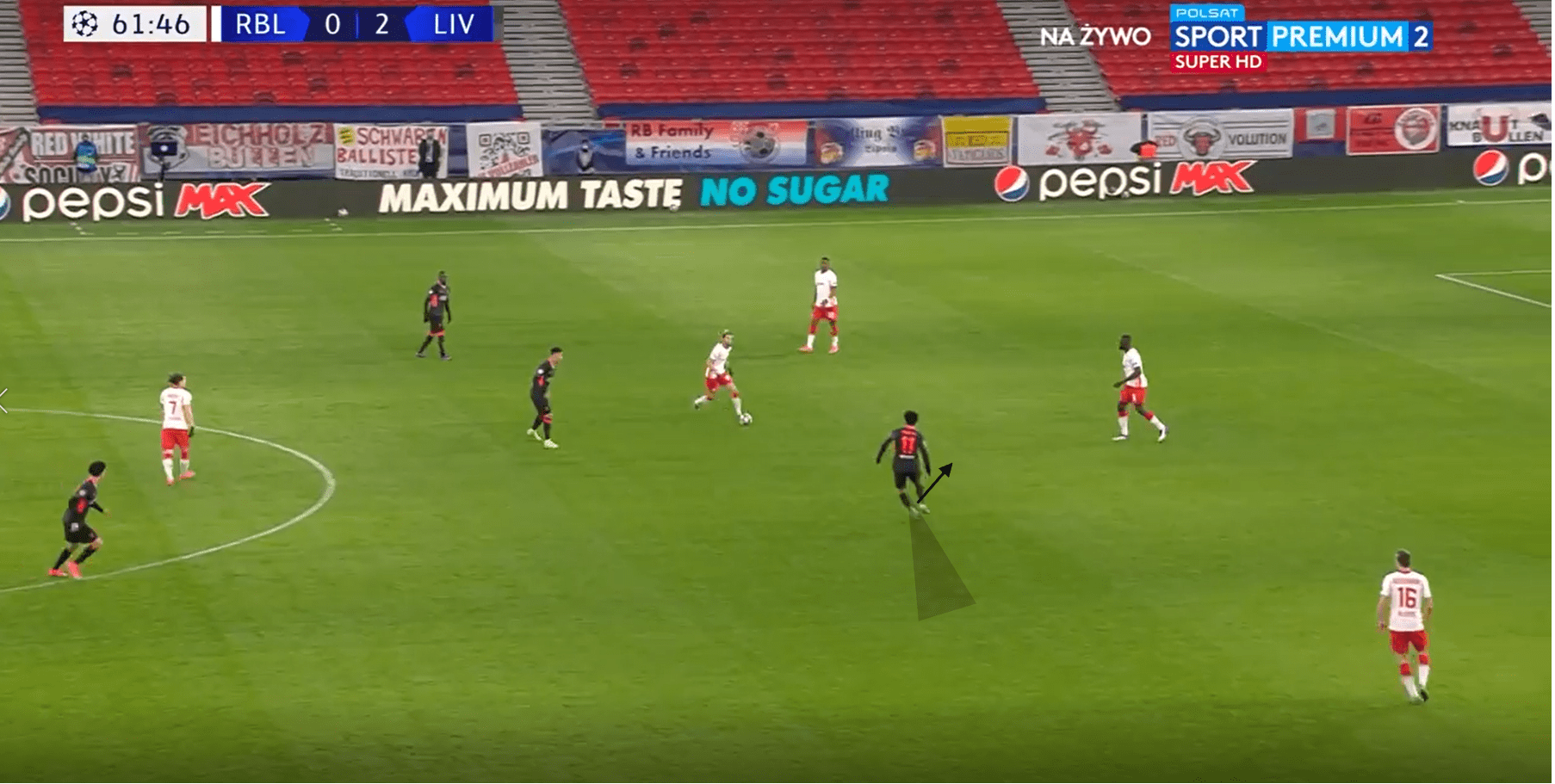
Pressing Upamecano in this way could have been targeted individually, or it could have been to prevent Leipzig from progressing through their middle centre back, which is something Nagelsmann’s Hoffenheim did well against Liverpool in their 2017 match. Kevin Vogt, the middle centre back, was able to consistently exploit the passing lane between the inside forward and wide central midfielder as we see below, and this was down to a lack of pressure on the ball from Liverpool and the overloading/not optimal positioning of central midfielders. Liverpool fixed both of these issues in this match.
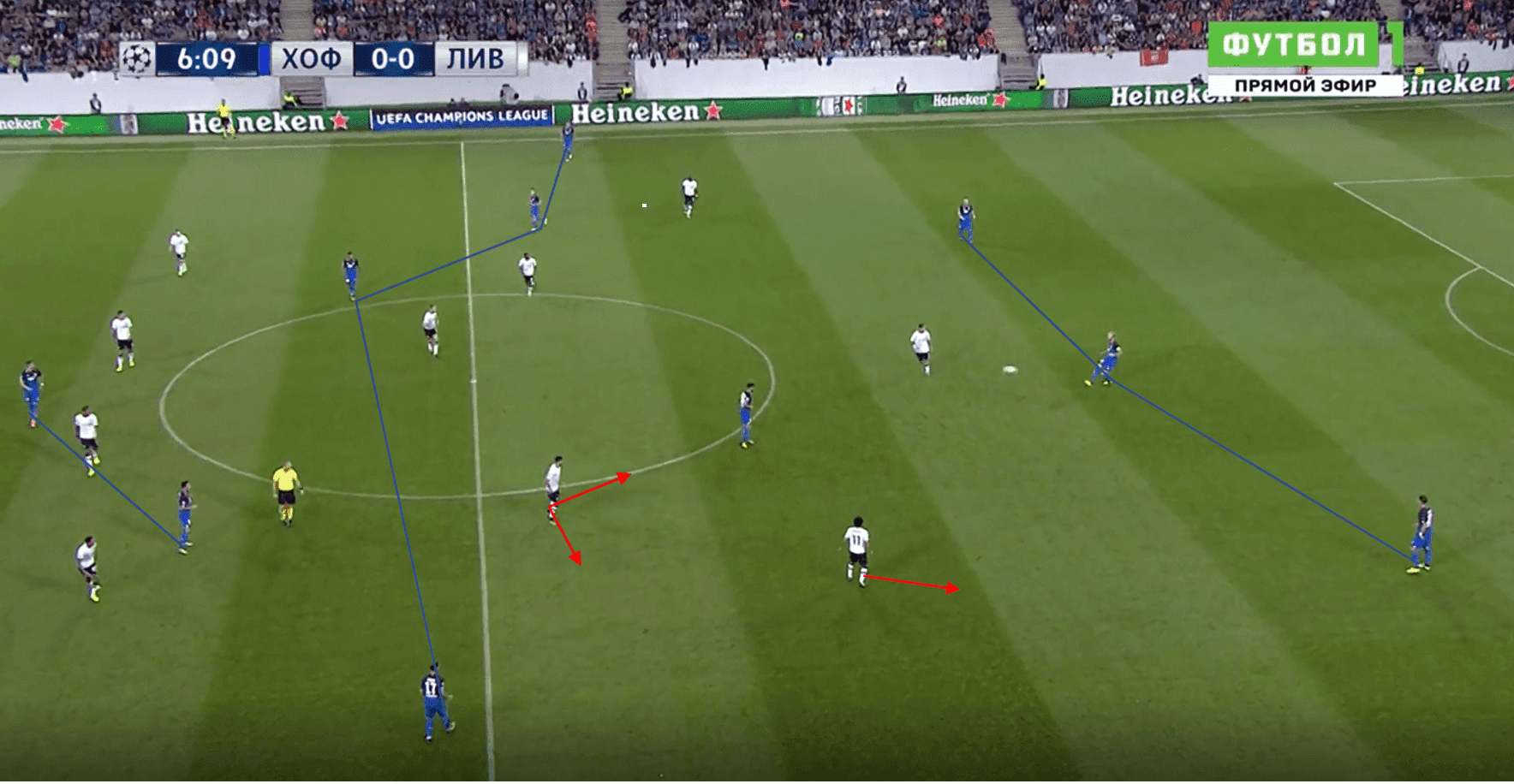
With Upamecano pressed quickly, accessing this lane became much more difficult, but it was also made more difficult by Liverpool’s good shifting in midfield. If we look at the example above for example, you can see that Emre Can is able to be overloaded in part down to the fact that he has to remain quite narrow to press. If Liverpool can shuffle quickly and get across, the middle central midfielder can perhaps press Demirbay here, and so Can could remain more stable and Hoffenheim would struggle to progress.
Liverpool’s central midfielders in this game, facing a similar formation, did just that and together with the forwards who helped to make play predictable and prevent switches of play across the back three, they were successful in pressing higher and limiting build-up through wide areas. We can see a nice example here where Mané is able to apply pressure along with Firmino to force a central pass, with Thiago starting wider. Leipzig aren’t looking for that exact pass shown above, but the concept is the same in terms of increasing cover on the wings for Liverpool. If they don’t shuffle across well here, left central midfielder Thiago likely has to press the dropping Leipzig player here, who if they can then access the wide centre-back, can play out comfortably. But because Wijnaldum is further across and can follow Olmo, Thiago can stay wider and cover this lane.
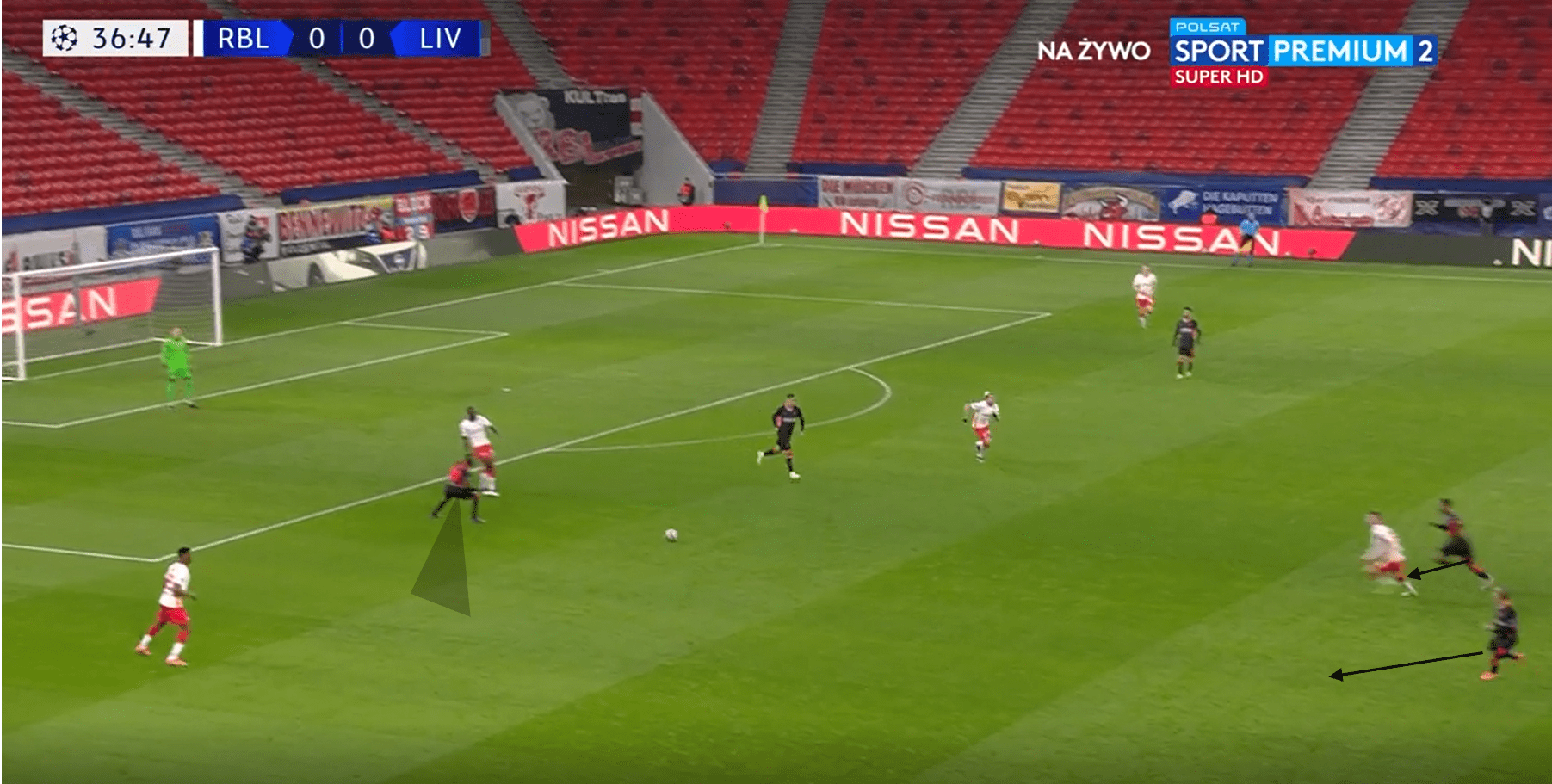
We can see here Thiago covers the lane really well, and again Liverpool’s shifting allows him to do this. This is also underpinned by the first line maintaining pressure on the ball, and by also arcing runs to prevent wide centre backs from receiving switches in play, as this would obviously hurt Liverpool’s shifting. Roberto Firmino in particular against Upamecano as able to cut off one side of the pitch to make play more predictable and prevent Leipzig from shifting the ball.

Curtis Jones here gets nice and wide to press the wing-back, with Leipzig trying to pin Andy Robertson back initially. Again if we look at that midfield three we can see how compact and shifted across it is, which helped to limit Leipzig’s ball progressions. Liverpool’s pressing on the whole was good, especially in higher areas, and Klopp could be seen on the touchline celebrating certain pressing scenes, with one in the 78th minute where Alexander Arnold commits to cover a central midfielder and wins the ball.

All of these concepts come into play in this example here, with Firmino pressing Upamecano into one side of the pitch with support from Salah, and central options marked. Liverpool aren’t shifted too well, but this doesn’t actually matter because there isn’t any attackers to shift across with, and so Upamecano just falls into the trap of playing a bad pass that Alexander Arnold is alive to, and Liverpool can counter. You then have to just look at that rest offense in the picture, and Salah immediately runs and is found by Alexander Arnold between the two nearest centre backs, which is a key advantage of pressing in this way.
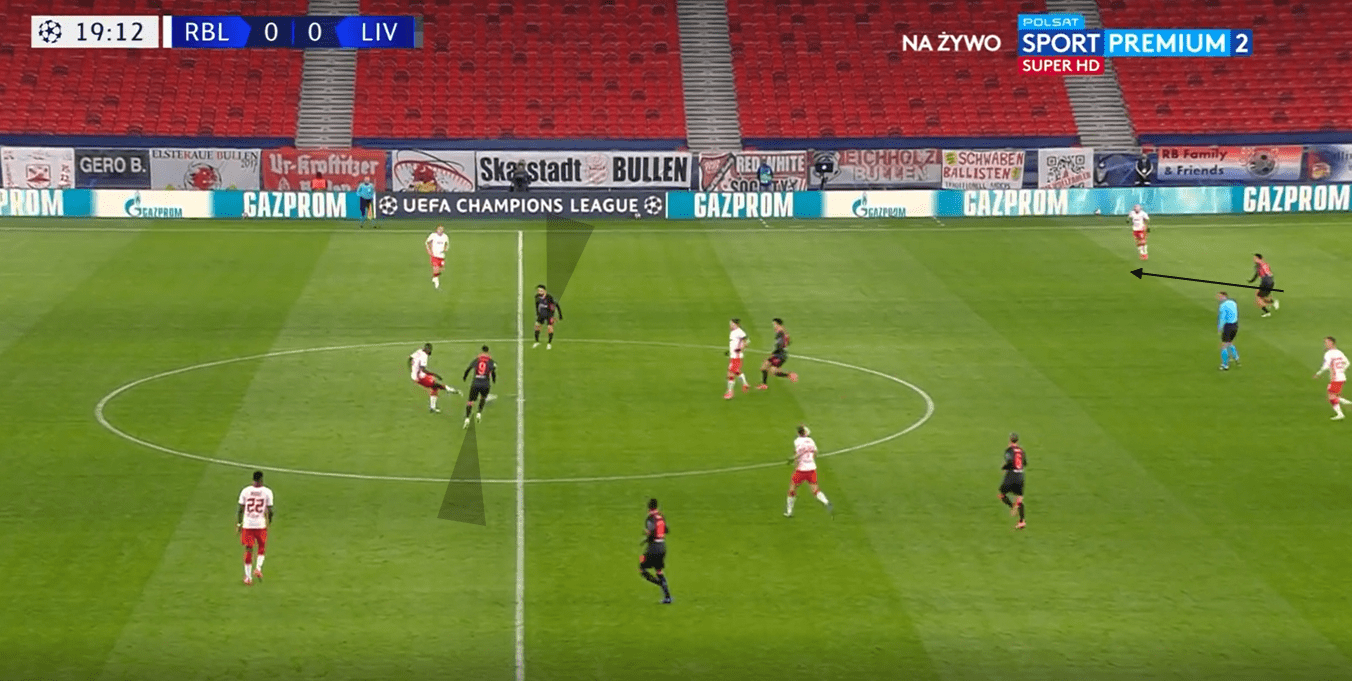
Leipzig positional play
Despite Liverpool’s good pressing, Leipzig did have some moments in the game created via their positional structure, and they were able to near enough match Liverpool in terms of chance creation according to xG. Again if you watch Leipzig regularly most of the concepts were nothing new, with the main topic within this being their overloading of an area to isolate another player.
We saw this happen a few times throughout the game with Angeliño, with this a common pattern within Leipzig’s play. Dani Olmo who started as a striker would often drop off into deeper areas to receive, and we see here he moves into the half-space to receive. The two centre backs are pinned by the movements of the two Leipzig strikers in behind, and so Olmo can receive freely.

Striker Yussuf Poulsen moves onto Trent Alexander Arnold, and so Angeliño’s late movements cannot be tracked, and so he gets a shot on goal which goes wide. Angeliño managed three shots on goal in the game with a total value of 0.26 according to Wyscout, and so although this didn’t create massive goal-scoring chances it certainly helped to create shooting opportunities, and he is usually pretty good in shooting in these areas. We can see the Leipzig player on the ball here is surrounded by Liverpool players, who end up too compact here with Salah not able to track back. As a result, Klopp brought on Neco Williams late on to switch to a 4-4-2 and maximise horizontal coverage of the pitch.

Leipzig’s midfielders were aggressive in getting at Liverpool’s last line to create overloads in this area, and we can see an example of a 5v4 being created by Tyler Adams’ late movement at the back post. While pushing midfielders on, they still maintained a good rest defence thanks to Kevin Kampl and their athletic centre backs, and so their counter-pressing was not affected too much.

Leipzig would often take up a 3-1-6 structure in higher areas, and a key part of this was the movements of the wing-backs and central midfielders. In order to dismark Liverpool’s central midfielders, central midfielders would often rotate with wing-backs, with wing-backs inverting to take up positions in the half-space. We can see an example below where Haidara moves from a central position to a wider area, while Tyler Adams inverts from the wing-back position. With Haidara initially positioned behind Thiago, it makes it difficult for the Spaniard to track his run wider and adjust his position accordingly.

We can see here Adams moves inwards rather than supplying width, with Hwang Hee Chan moving behind Henderson, who looks to step up in midfield badly. Poulsen drops deeper to receive and access Olmo, who positions himself behind Jones who is caught too high.

Leipzig also looked to create double width at times in their build-up, with a central midfielder dropping wide along with a wing-back, as I mentioned previously when looking at Liverpool’s pressing in this area. Jones presses the wide player here while Robertson is occupied by a wing-back, and Leipzig therefore looked to use this to stretch Liverpool’s midfield and create overloads, however they weren’t able to do this consistently. We can see Kampl acts as the free player here, until Wijnaldum passes Olmo onto Henderson.

They use the same concept in a deeper area here with a wide centre back and wing-back, with Thiago’s wide pressing avoided and a free player created in the middle, with Wijnaldum already occupied deeper. Liverpool can’t cover all options, but they put enough pressure on the ball and make the build up difficult enough so that Leipzig misplace the pass here and Liverpool can counter.

Conclusion
The game was an even one and on first viewing I could not really have said one team ‘deserved to win’ over the other, as both teams had their moments. On the whole though I think Liverpool did narrowly deserve the win, but Leipzig had the opportunities to score, with the difference in individual quality probably deciding the game in both phases for Leipzig. As mentioned in my analysis, Liverpool forced mistakes and dealt pretty well with Leipzig’s build-up, and Liverpool looked far more comfortable when they maintained possession and could control the game. Leipzig likewise pressed Liverpool well, and so it was no surprise to see that both managers were pleased with the overall performances of the team, but Nagelsmann will again be ruing silly individual errors and a lack of quality offensively. The tie is far from over and it will be interesting to see how both teams approach the return leg, with Nagelsmann sure to have something up his sleeve to pose Liverpool a new problem.





Comments